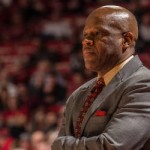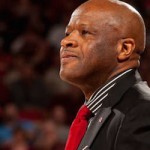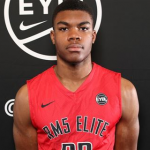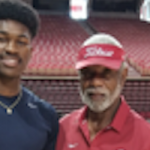By Kevin McPherson
Super Sid was in the house last Saturday, and this time you’ll be happy to know he’ll never leave home again. His famous name and No. 32 are now fixed forever in Hog Heaven like a bold, powerful star in the night sky that burns bright every night, reliably and without fail — a fitting description of Sidney Moncrief the player, to be certain.
On Saturday, Super Sid came back to a super-sized version of his original house, which was Barnhill Arena, where from 1975-79 he was the standard for player greatness never before seen and not seen since. On this visit, that greatness was immortalized and represented by his name and famous No. 32 on a giant banner that was raised to the rafters where it will hang forever in Bud Walton Arena — a trophy-arena that never had its court graced with his rhythmic, tenacious pace or its rims rocked by his soaring, electrifying dunks. A near-20,000-seat palace that likely wouldn’t exist if not for his greatness.
In case you didn’t know how to spell out “Arkansas basketball icon,” it’s now done for you at the top of that celestial banner: M-o-n-c-r-i-e-f.
Sidney Moncrief — the player-architect and patron saint of the bridge connecting a 25-year span crossing four decades that saw the Arkansas Razorbacks become one of the elite programs in college basketball, and really you could say he’s the driving force behind the birth, growth and vitality of basketball at all levels in the state of Arkansas … almost out of nowhere and seemingly from nothing when you consider Sidney Moncrief was not even the highest-regarded incoming Hog freshman from Little Rock in 1975.
Today, the name Sidney Moncrief is not just synonymous with greatness, but it’s THE name of THE GREATEST Hog to ever lace them up, arguably in any sport at the University of Arkansas.
Saturday’s event during Arkansas’s 61-41 blasting of Mississippi State had all the trappings of family reunion and celebration, with his Triplets teammates on hand among nearly 16,000 adoring Hog fans (all available seats in Bud Walton Arena were sold, we were told by the UA). The University of Arkansas honored Super Sid with a long overdue ceremony during halftime, raising that retired jersey-No. 32 as the first individual player to be honored in this way so that generations of Hog fans can look up and either remember him fondly or dream of what it must have been like when he played.
I’m one of the fans who remember him fondly, and still dream of what more he could have accomplished as a player had chronic tendinitis in both knees not cut short a brilliant career.
I remember a player who was equal parts blue-collar, great athlete and fiercely competitive while simultaneously being
I remember a true great who didn’t celebrate himself after a spectacular dunk or offensive play, but rather identified his man defensively and hustled back — no, sprinted back — to D him up … because true greatness doesn’t pause to celebrate itself, and Sid understood that achieving it and maintaining it was always a work in progress, so he never cheated the work part of that greatness equation.
I also remember that Sid had hustled home a quarter of a century ago for a different kind of retirement ceremony. After playing in Arkansas and beyond for nearly 20 years and being beloved at every stop along the way, he returned in 1989 as a highly decorated superstar of the NBA’s Milwaukee Bucks to say goodbye to the game that he had given so much more than it could ever give him back. So, he chose his high school gym, the old original one at Little Rock Hall, for his retirement press conference.
At a time when all we wanted was to see him hang on and rekindle that greatness, Super Sid’s knees had little left for basketball, but plenty enough to walk him onto his high school court where a podium was set up to welcome home a basketball god who was now in street clothes to deliver the sad but inevitable news.
Local media flocked to cover his farewell presser. And before this day, Sid had already answered all the important basketball questions that a 20-year-old reporter for the Arkansas Gazette would ever need to know about his game.
Did he take away your best scorer? Check. Take away your bigs by owning the glass at only 6-foot-4? Check. Take your breath away by launching from ground zero and punctuating a graceful but electrifying flight with an emphatic two-handed slam? Check mate! And those were just a few of the many elite-level components of Sid’s game that made him of one of the 5 best players in the world by the mid-’80s.
Plus, his stats and accolades over the years spoke plainly enough to his contributions and greatness as a player:
* One of only two Hogs to score more than 2,000 points in a career
* All-time leader in rebounds as a Razorback, and at or near the top in field-goal percentage and free throws
* Arkansas’s only 1st team All American
* Led the Hogs to their first Final Four in the modern era of college basketball in 1978 as a junior
* Took the Hogs back back to the Elite Eight the following season as a senior in an epic battle against legendary Larry Bird.
* 5th player selected in the 1979 NBA draft
* 5-time NBA 1st or 2nd team all-pro
* 5-time NBA All Star
* Twice named NBA Defensive Player of the Year
* 4-time NBA All Defensive first-team, and 1-time 2nd team
* Led Milwaukee to 8 division titles in his 10 seasons there
* First NBA player in over a decade to lead his team in minutes, scoring, rebounding, and assists.
* Led the Bucks to the third-best record of the ’80s behind only the Boston Celtics and Los Angeles Lakers
* 2-time cover boy of Sports Illustrated
* His Milwaukee No. 4 jersey was retired by the Bucks in 1990, and it’s hanging in the rafters of their arena.
Then there were the quotes and thoughts from legends of the game. The greatest player of all-time, Michael Jordan, who came into the league in 1984, credits Super Sid with some of his most important basketball lessons on the pro level. “When you play against Moncrief, you’re in for a night of all-around basketball. He’ll hound you everywhere you go, both ends of the court. You just expect it.” A respectful description to the Los Angeles Times praising Sir Sid’s full-court intensity. Then there was Hall of Fame coach Don Nelson, one of the longest tenured coaches in NBA history whose coached more than one HOF player, who was always on record to acknowledge that Sidney was the greatest player he ever coached.
Greatness that someday will be — must be — recognized by the Naismith Basketball Hall of Fame, because while Magic and Bird are credited with saving pro basketball, Sidney was right beside them doing the dirty work on the defensive end that eventually led to a revolution of being accountable on that end of the floor in a league forever known for its offense. It was his devotion to relentless, lunch-pail, physical, dig-in-and-D-up play that helped transform the game into what you see today — a game that values defense.
But getting back to Sid’s retirement press conference back in 1989, a young reporter had already heard Moncrief through his actions on the floor, but he still had questions. He wanted so badly to pay attention to every single word from a local living legend, to focus on his facial expressions, his tone, and his body language. So that the reporter could help tell the story of this day to readers, and to choose words that would fittingly help sew up a brilliant career. But the mind could not fight back the flood of images from watching his excellence and greatness over the previous 14 years. It was a Sidney Moncrief highlight reel playing on a loop in the mind while Sid was up there speaking of his retirement from basketball.
Then suddenly, the reporter stopped focusing on his childhood hero standing in front of him, and turned to look at the group of reporters and supporters who came to be a part of this day. At that moment, the role of the reporter became crystal clear: What did Sidney Moncrief mean to others here at home, who saw it through from beginning to end?
So, I asked them.
“He’s simply the best, and I am so proud of Sidney,” was all Wadie Moore, then lead beat writer/editor for high-school sports at the Arkansas Gazette, could get out when asked, and those were more like the words of a doting father, not a journalist covering an event.
For former Little Rock Hall and Razorback guard Allie Freeman, Sid was a leader of a basketball revolution that made basketball-loving kids in Arkansas dream big and believe in themselves: “Sidney paved the way for all of us. He’s meant so much to so many who see they have a chance to follow in his footsteps to bigger things, even if they don’t make it all the way to the NBA.” Allie sounded like a proud little brother expressing gratitude and admiration, something that a long line of young Arkansas basketball players have surely done in one way or another over the years.
Sid’s high school coach, long-time Hall High leader Oliver Elders, chose to emphasize and re-emphasize that Sid’s greatness was a self-made greatness. ” He worked so hard, was so determined. It was a daily thing, and he never took a day off. I was his coach, yet I admired him.”
It was fitting that the last person I asked gave me the most profound answer of all. The late, great, incomparable Paul Eells answered a question with a question in revealing that Sidney Moncrief was/is/and always will be the center of the basketball universe in the state of Arkansas.
“Before Sidney Moncrief and the Triplets, what was basketball here?” Paul asked. “He didn’t just make Arkansas fans wake up to basketball, he made them live it with a fervor.”
Yes sir, he did. Mr. Eells nailed it!
Sidney Moncrief the teammate — along with fellow Triplets Ron Brewer, Sr., of Fort Smith, and Marvin Delph, of Conway — was at the epicenter of a 25-year Razorback quake registering 1 national title, 2 title-game appearances, 4 Final Fours, 6 Elite Eights, 8 Sweet 16s, 22 NCAA appearances in 25 seasons, 11 final Top 10 national rankings, 2 HOF coaches, 2 Olympic gold medalists, 3 NBA All-Pros, and numerous other NCAA and NBA team and individual awards.
What Sid accomplished individually and as part of a team in those early days with Eddie Sutton and the Triplets — when it had never been done here before, when nobody had previously paid attention, expected much, or even cared — was so much more than just a player-architect drawing up a bigger, better blue-print. He was that powerful, undeniable spark for a big bang that eventually expanded into mass fan adoration and awe that reached all four corners of the state — and it was not just a love and respect that grew for him, but a love and respect that grew for a sport that had always been an afterthought around here.
The player and the sport were inseparable, one in the same. He was/is/and always will be the center of our basketball universe in Arkansas. So, the next time you visit Bud Walton Arena and look up to scan the rafters for his name and that famous No. 32, think of yourself as transported to a planetarium and gazing up at the stars. That big one up there — the biggest star — is Sidney Moncrief. And that is how you best contemplate, measure and understand his true greatness.
* * *
Kevin McPherson, who started a writing career at the Arkansas Gazette in the late 1980s before moving into the business sector, is a free-lance writer and Arkansas sports fan in his spare time.














